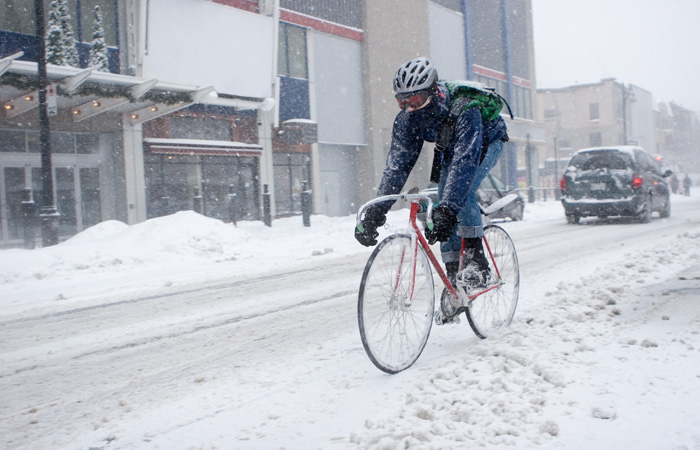Rethinking Lifestyle
Don’t Park Your Bike in Winter

It’s that time of year again, the time when folks who have enjoyed cycling in summer, park their bikes. I say, whoa, not so fast! True outside mobility, whether it’s walking, jogging or cycling is different in winter than it is in summertime, however that is not reason enough to eliminate it. I have noticed this summer, that there is a spike in bike traffic mornings and evenings when folks are coming and going to work. These folks will need to decide how they get to work, but in this column I want to address folks in my situation: retired but active.
As a retired person, I don’t need to get to a job site, nevertheless I still want to get around reasonably efficiently. I also want to be physically fit, I want to live comfortably within my means, and I want to do my part to pass a friendly world on to my children and grandchildren.
I frequently encounter people who express incredulity when they hear I cycle in wintertime. My response is that when moving between two points within Steinbach, you have four options:
- get into a cold car, and arrive at your destination cold (with no sense of accomplishment),
- warm up your car for 15 minutes, get into a warm car and get to your destination warm (also with no sense of accomplishment),
- walk to your destination appropriately dressed, arriving warm and invigorated, but late,
- bike to you destination appropriately dressed, arriving warm, invigorated and on time.
Cycling in winter is not as challenging as it appears to be. The longest bike-run I make in winter is less than 5 km. This allows me to get from my house to any point in Steinbach. Cycling that distance, I don’t need special clothing. Before I leave home I decide what I am going to wear. If I decide well, I am comfortable when I reach my destination. If I decide poorly, I’m either hot or cold. The clothing that would keep me warm walking will also keep me warm cycling. Actually, because cycling requires more physical exertion than walking, I frequently wear slightly less clothing when I am cycling than when I walk.
With respect to my bike, my main modification is fenders (for those slushy days). I also ensure that I have aggressive knobby tires. Tires with studs are also available for bicycles, and the studs certainly make a difference on ice, but I have found the studs wear off in a year, and the knobbies are almost as good. However I note that packages of studs to add to your tires are available, and I’m thinking of modifying my tires with that for this winter.
Face protection is essential. I now prefer a wool scarf to a belaklava. The scarf covers the lower half of my face and a good tuque drawn well down covers my forehead. I cover the scarf and toque with the light hood on my ski-jacket, draw the string tight, and am ready to face all but the coldest, strongest north wind.
But wind is a challenge – not because it is cold, but because it drifts snow. Cycling after a light snowfall is no problem, but cycling through drifted snow, is a challenge. Drifted snow may be reason enough to park the bike and walk. Fortunately the City is very good at plowing both our streets and sidewalks. Once the streets have been plowed and the intersections sanded, cycling is really no problem.
The occasional wipe-out when cycling in winter is inevitable. Rutted streets are especially bad. But the chance of injury as a result of a wipe-out in winter time is low. Packed snow is not nearly as hard as concrete or gravel, and winter clothing gives significant protection. Icebike, a biking website, did a survey of winter cyclists and found that all had had unplanned encounters with the ground, but where this happened in winter time, less than 1% of such accidents required hospitalization.
Basically the argument for biking in winter is not significantly different than the argument for biking in summer. What keeps you from biking in winter is mental, not physical.




